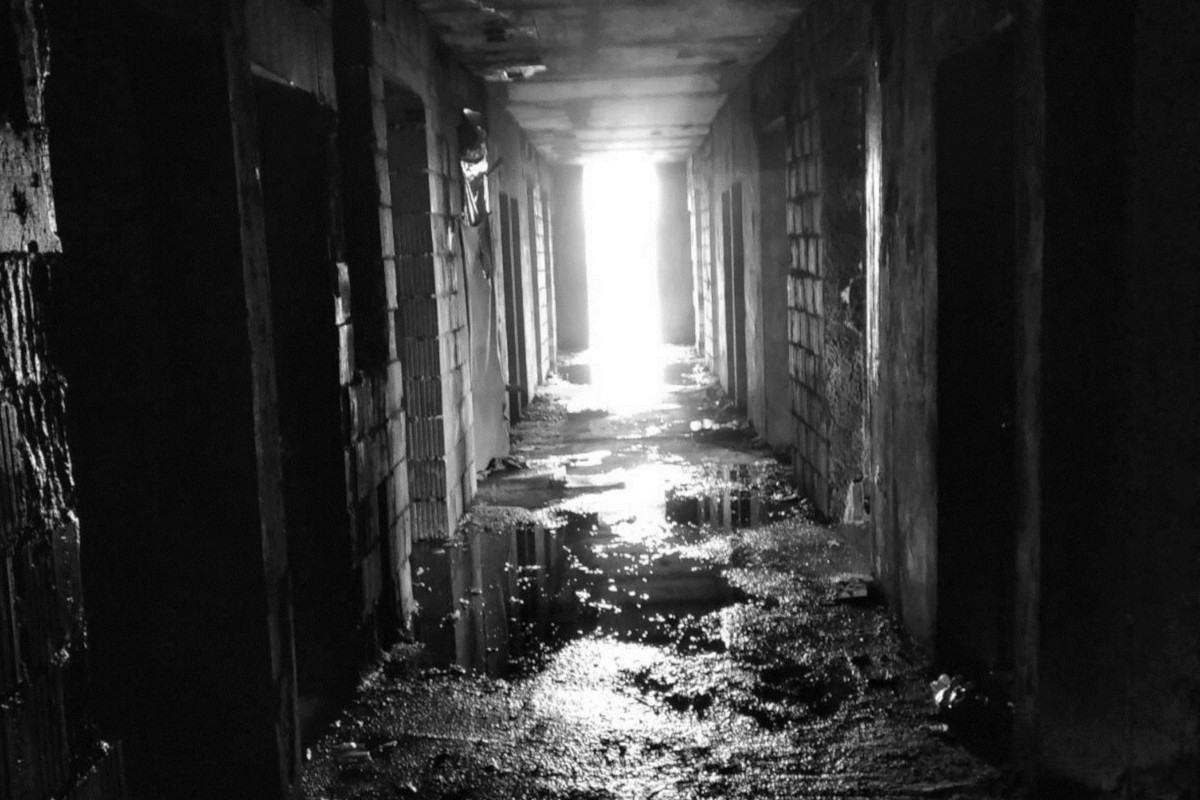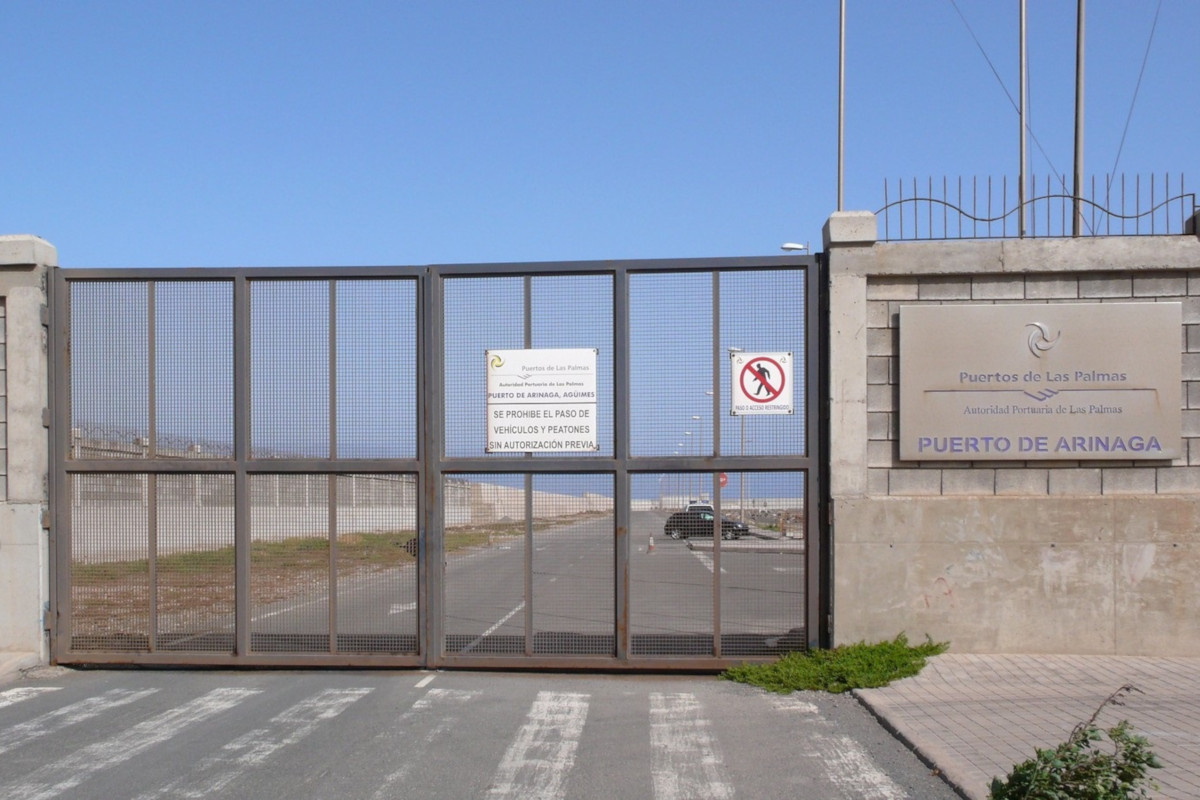Foreign agents and violence against migrants at the Greek-Macedonian border
Topic
Country/Region
08 June 2021
An increasing number of reports of violent pushbacks at the Greek-Macedonian border have been collected by volunteers in recent years. Some reports allege the presence of Frontex, but bilateral policing deals in place may also explain the presence of foreign officers in Macedonia. The violence underpins a long-standing plan to close the ‘Balkan Route’ and keep people out of ‘core’ EU territory. Whoever is behind the violence, there is no shortage of border guards to mete it out – but justice is in short supply.
Support our work: become a Friend of Statewatch from as little as £1/€1 per month.
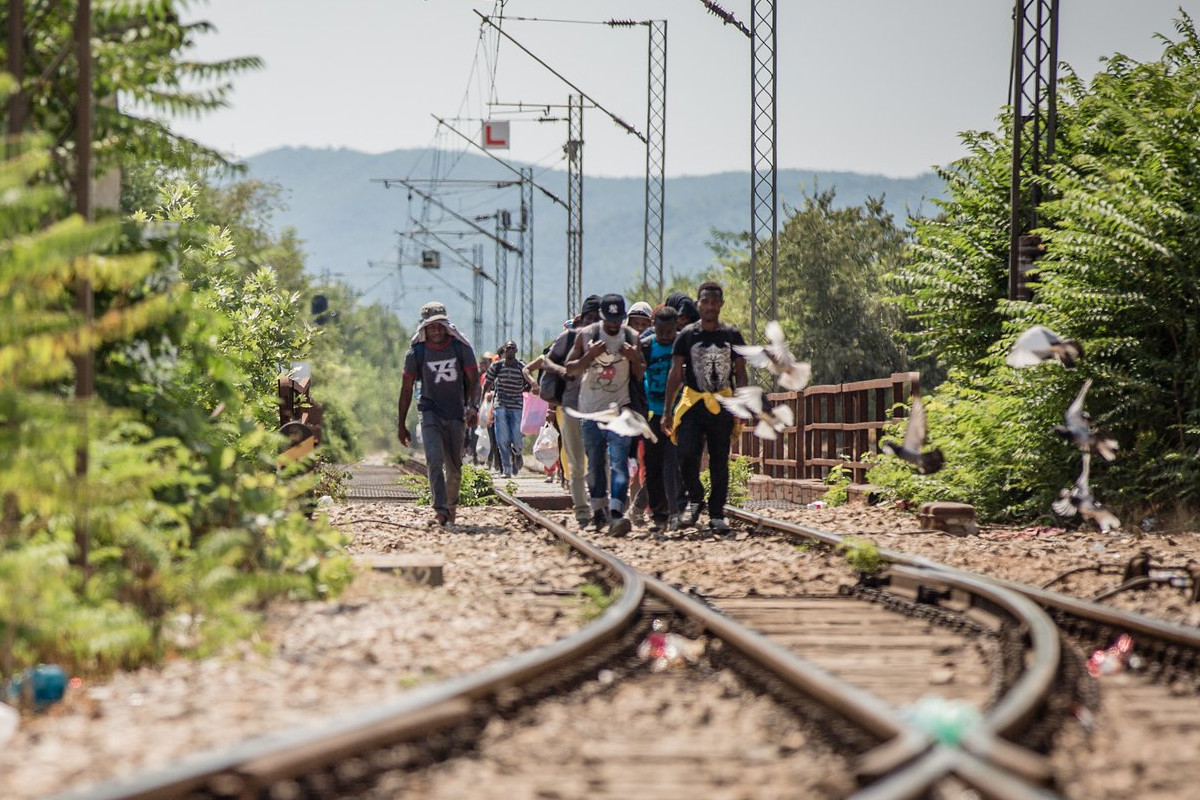
In 2015, a group of people make the last part of the crossing from Greece into what is now Northern Macedonia. Image: IFRC, CC BY-NC-ND 2.0
Midnight in Macedonia
Around midnight on 14 August last year, a group of some 20 people were intercepted by border police just north of the Greek-Macedonian border, near the small town of Gevgelija. What happened next, according to the testimony of one member of the group, makes for grim reading.
“[T]he police officers approached the group and became physically violent. The officers struck various group-members with their batons. Others were pepper-sprayed, including the women and children. After this, the officers loaded the group into a van and left them there without any air conditioning, jammed, soaking in sweat for around two hours, while going about to catch more transit groups. In the end, they squashed around 40 people in a van for fit for ten persons.”[1]
Macedonian officials were not the only ones involved in the operation. The testimony also recounts “foreign officers wearing uniforms with the European Union flags on their shoulders,” the distinctive mark of EU border agency Frontex.
Foreign agents
The testimony is one of five reports gathered by Border Violence Monitoring Network (BVMN), altogether involving some 130 people, that describe violence being meted out in the presence of, or even by, border guards allegedly deployed by Frontex on North Macedonian territory. A further 10 reports gathered by the network, encompassing some 123 people, recount the use of violence by foreign border guards and police officers operating in North Macedonia, but do not mention uniforms bearing the EU flag.[2]
Statewatch and Border Violence Monitoring Network have written to Frontex to demand an investigation into the allegations recounted in this article. Read more here.
The violence recounted in those testimonies is shocking. According to the report on the 14 August incident, after cramming people into the van, the police drove them to the banks of the Vardar river. There, they threw peoples’ possessions into the water, took their phones and money, and “the group was beaten brutally with metal electroshock batons and some people were thrown into the river by the police. One person was thrown in despite crying and begging not to be thrown in.” They were subsequently taken back to the border and pushed through a gate leading to the Greek side, while police beat them with electroshock batons.
In that incident, the witness said that officials with uniforms bearing EU flags were present, but did not directly participate in the violence. But a report from the same area, concerning an incident less than a week later, refers to officials in uniforms bearing Croatian, Slovenian, Czech and EU flags, who bound a group of four men with zip ties and beat three of them with batons (one of the group, who was a minor, was spared the beating).[3] Reports of other incidents allege the presence of Italian, German and Austrian officials.
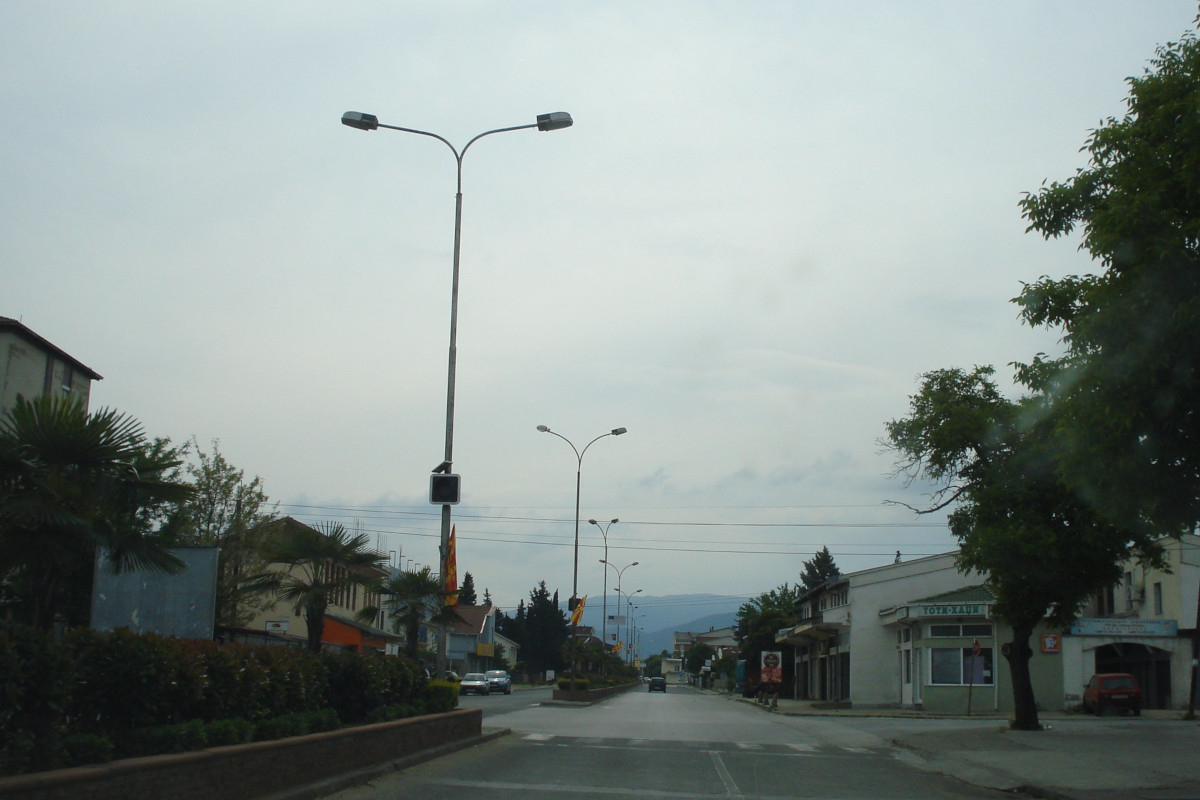
The town of Gevgelija in Northern Macedonia. Much of the violence recounted to BVMN is alleged to have taken place near here. Image: george k. 1981, CC BY-SA 2.0
No reports at Frontex
While BVMN volunteers have gathered multiple testimonies that allege Frontex’s presence or involvement in violence in North Macedonia, the agency itself says it has received no reports of any such incidents. The agency also denies any presence in the country – in May, a press officer told Statewatch that “Frontex does not have any operational activities at the land border from the North Macedonian side,” and “is only present on the Greek side of the border.”
In December 2020, Frontex responded to an access to documents request filed by Statewatch some months earlier. The request sought copies of all serious incident reports (SIRs) concerning the agency’s activities at the Greek-Macedonian land border from 1 January 2020 onwards. SIRs are supposed to be filed by officials deployed on Frontex operations for a variety of reasons, including in case of “suspected violations of fundamental rights or international protection obligations.”[4]
In its response, the agency said that it did not hold any SIRs concerning the geographic area and time period covered by the request. This does not mean, however, that the incidents recorded by BVMN did not take place – it may simply be that nobody is reporting them.
A working group set up by Frontex’s own Management Board, in response to allegations of involvement in pushbacks in Greece, found numerous problems with the agency’s reporting system. It noted that there was no way of monitoring the quality of reports submitted, and there were no confidential avenues for team members to report rights violations by their colleagues.
The report also called for “a newly introduced culture,” suggesting that the existing ambience at the agency is not one in which the rights of migrants and refugees are at the forefront of officials’ minds. The working group said that the agency needed “awareness of and sensitiveness towards possible misconduct,”[5] a call it repeated in its final report.[6]
Not even numbers
Serious incident reports may not exist, but the request from Statewatch to Frontex also sought to establish the scale of the agency’s activities at the Greek-Macedonian border through another means – by requesting data on the number of migrants and migrant smugglers apprehended at the Greek-Macedonian border over the same period (1 January 2020 onwards).
This data, argued Frontex, could not be released – doing so “would jeopardize the work of law enforcement officials and pose a hazard to the course of ongoing and future operations aimed at curtailing the activities of such networks,” despite the request seeking nothing more than figures that Frontex itself has published in previous reports.
A public evaluation of the tongue-twistingly titled ‘Joint Operation Flexible Operational Activities 2018 Land on Border Surveillance’ (JO FOA Land) says that in 2018, 16,337 migrants and 313 smugglers were apprehended in the area covered by the operation – “the ‘green borders’ of Greece with Turkey, the North Macedonia [sic] and Albania, Bulgaria with Turkey, North Macedonia and Serbia.”[7] Yet for reasons known only to Frontex, providing a breakdown of these figures for the Greek-Macedonian border would apparently undermine public security.
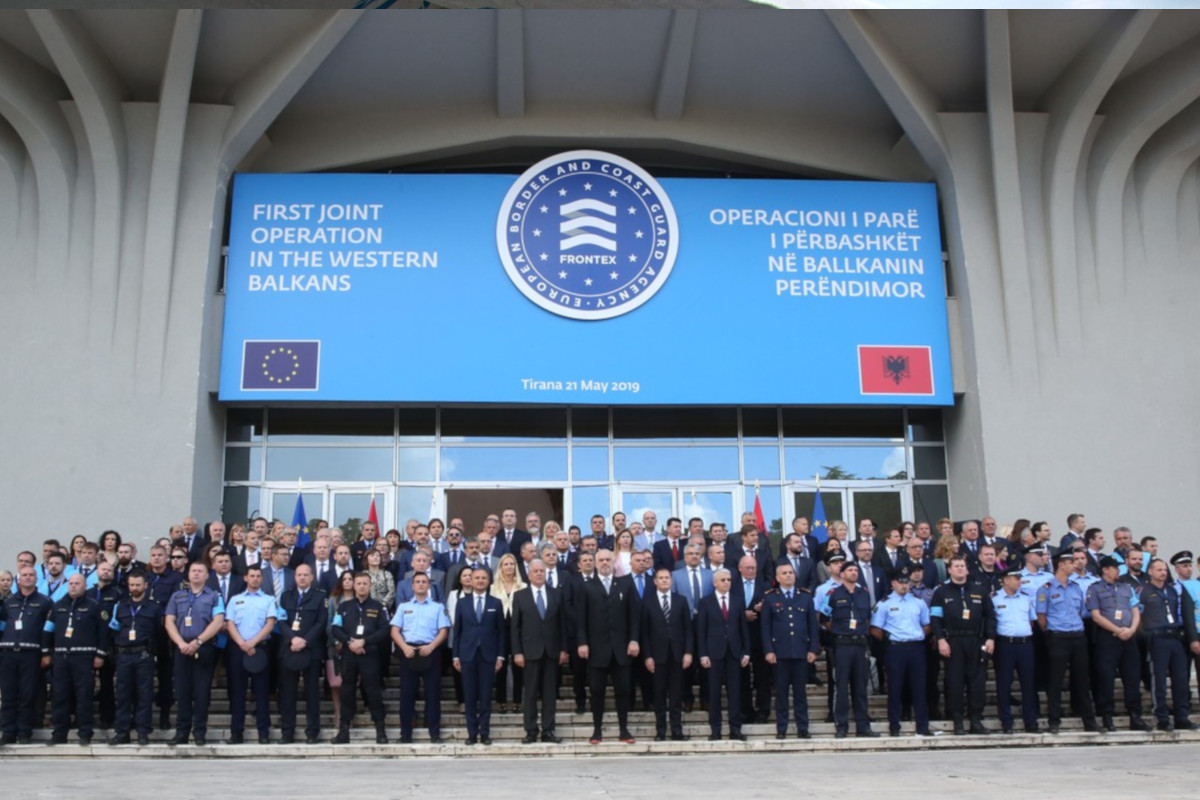
Frontex and Albanian officials mark the launch of Frontex's first official operation on non-EU territory, in Albania in May 2019. Image: Frontex
A significant presence
According to Frontex’s evaluation report, 25 member states took part in operations at land borders in south-eastern Europe in 2018, along with 47 officers acting as observers from six different “third countries”, namely Georgia, North Macedonia, Kosovo, Moldova, Serbia and Ukraine. Over 1,800 officials were deployed by Frontex over the course of the year. The operations recorded 2,011 “incidents”.
A substantial Frontex presence at the border between Greece and North Macedonia has been in place since then. In a response to a parliamentary question from German MEP Özlem Demirel, the European Commission said last June that at Greece’s land borders with Bulgaria, North Macedonia and Turkey, 71 officials, 24 patrols and three “thermo-vision vans” were deployed as part of the 2020 edition of JO FOA Land. Thirteen different member states were providing contributions to the operation: Austria, Bulgaria, the Czech Republic, Germany, Hungary, Latvia, the Netherlands, Norway, Poland, Portugal, Romania, Slovenia and Spain.[8]
While Frontex denies any physical presence on North Macedonia territory, the testimonies gathered by BVMN that allege the presence or participation of Frontex officials in violent acts raise serious questions for the agency. All the testimonies concern incidents that took place in North Macedonia, where the agency has no legal basis to operate. An agreement between the EU and North Macedonia that would permit Frontex deployments, similar to those currently in place with Montenegro and Albania, is facing hold-ups due to objections from the Bulgarian authorities.[9]
Bilateral agreements
Frontex operations are not the only deployments of foreign officials in North Macedonia. As noted above, nine of the 15 reports gathered by BVMN describing the involvement of non-Macedonian officers in pushbacks to Greece make no mention of Frontex at all. There are, however, multiple references to violence being meted out by officials in uniforms bearing the flags of Austria, Croatia, the Czech Republic, Germany and Serbia.
The presence of some of these officials in the country is made possible by bilateral border control agreements. North Macedonia has cooperation agreements with eight other states in the region (Austria, Croatia, the Czech Republic, Hungary, Poland, Slovakia, Slovenia and Serbia), who provide the Macedonian authorities “with assistance from foreign police officers in patrolling the south border with Greece and in performing their daily duties.”[10] The agreement with Austria, Hungary and Serbia has come in for particular criticism, as it is a memorandum of understanding rather than a formal agreement, and therefore has faced no parliamentary scrutiny in Macedonia.[11] Germany, meanwhile, does not appear to have such a formal agreement with North Macedonia at the federal level – which makes the allegations of the presence of German officers puzzling – but the EU’s largest state has provided a ready supply of equipment, including vehicles, mobile thermal imaging cameras, boots and torches.[12]
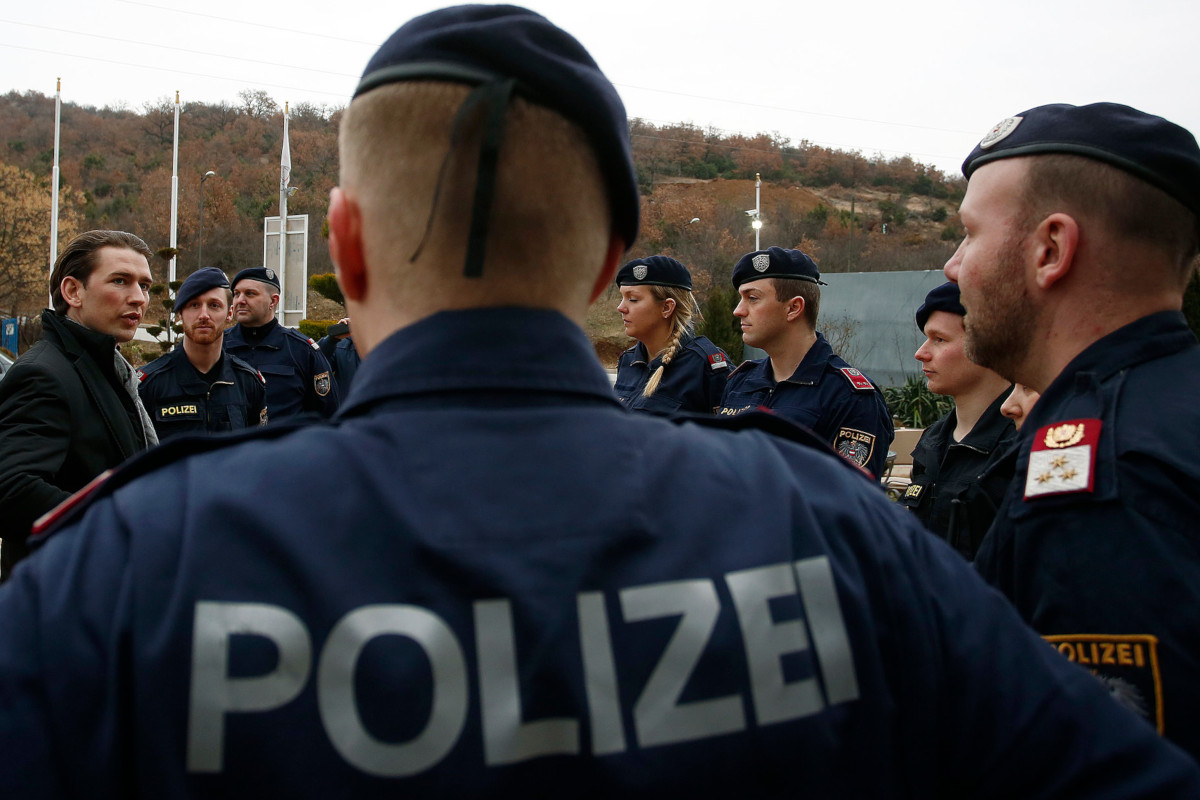
Sebastian Kurz (then the Austrian foreign minister and now the country's Chancellor) visits Austrian police officers deployed near Gevgelija in February 2017. Image: Österreichisches Außenministerium, CC BY 2.0
The Croatian and Czech governments have made extensive deployments under these agreements. Between December 2015 (when Croatia and North Macedonia signed a police cooperation deal) and February 2019 “over 560 Croatian police… intercepted almost 6,000 illegal migrants in North Macedonia.”[13] The Czech deployments have been even larger – by December 2019, “1,147 police officers [had] been sent to North Macedonia” to police the border with Greece, according to the Czech government.[14]
High-level police coordination preceded the signing of many of these agreements. In July 2016, the police chiefs of 12 states said that “the deployment of foreign police officers along borders which are strongly affected by irregular migration conveys a strong message that the countries concerned are resolute in jointly coping with the migration crisis.”[15] Under the agreements with Macedonia, foreign officials can “use technical equipment and vehicles with symbols, wear uniforms, carry weapons and other means of coercion”.[16] In some instances, it seems coercion tips over into outright violence.
An incident dating from 16 August 2020, recorded by BVMN volunteers, refers to officers “with black ski masks over their faces” and “Croatian and Czech flags emblazoned on their uniforms.” The interviewees said that “these officers were violent with them – kicking the group, destroying their mobile phones, taking their money, insulting them, pushing their faces on the ground with tied hands behind the back. One of the respondents was also attacked by a dog, while the officers [were] laughing at him.”[17] As far back as March 2016, an activist supporting refugees at the increasingly well-guarded Greek-Macedonian border told the newspaper Lidovky that, in Macedonia, “the Czech police are known for violence and unprofessionalism.”[18]
Buffer states in the Balkans
Bilateral cooperation between EU states and North Macedonia extends far beyond these police cooperation agreements. In September 2020, the German Presidency of the Council of the EU described the region stretching from Turkey to Hungary (known in official jargon as the “Eastern Mediterranean/Western Balkans”) as being “of great strategic importance for the EU in terms of migration management.”[19] Significant attention is therefore being given to reinforcing the ability of states in the region to control peoples’ movements (an issue highlighted in another recent Statewatch report).
As of May 2020, 15 EU member states were providing bilateral “support” on migration issues to states in the Western Balkans through a total of 228 activities, according to a survey carried out by the Croatian Presidency of the Council of the EU. The majority of that support was focused on control measures, “namely border management and combating the smuggling of migrants (over 50% of all MS activities),” said a summary produced by the Presidency. More than 50% of the 228 activities were taking place in Serbia and North Macedonia, both of which border EU territory.[20]
The Croatian Presidency highlighted the “geopolitical importance” of those two countries, given that “Member States’ focus is on the prevention of irregular migratory movements to the EU.” This was “both expected and understandable, but may contribute to strengthening the Western Balkan partners’ self-perception as a transit region, which poses a challenge for the further improvement of all aspects of their migration capacities.” Rather than a transit region, the plan is to provide ‘capacity-building’ and technical assistance to develop buffer states that can keep people out of the ‘core’ of the EU after they depart from Greece.
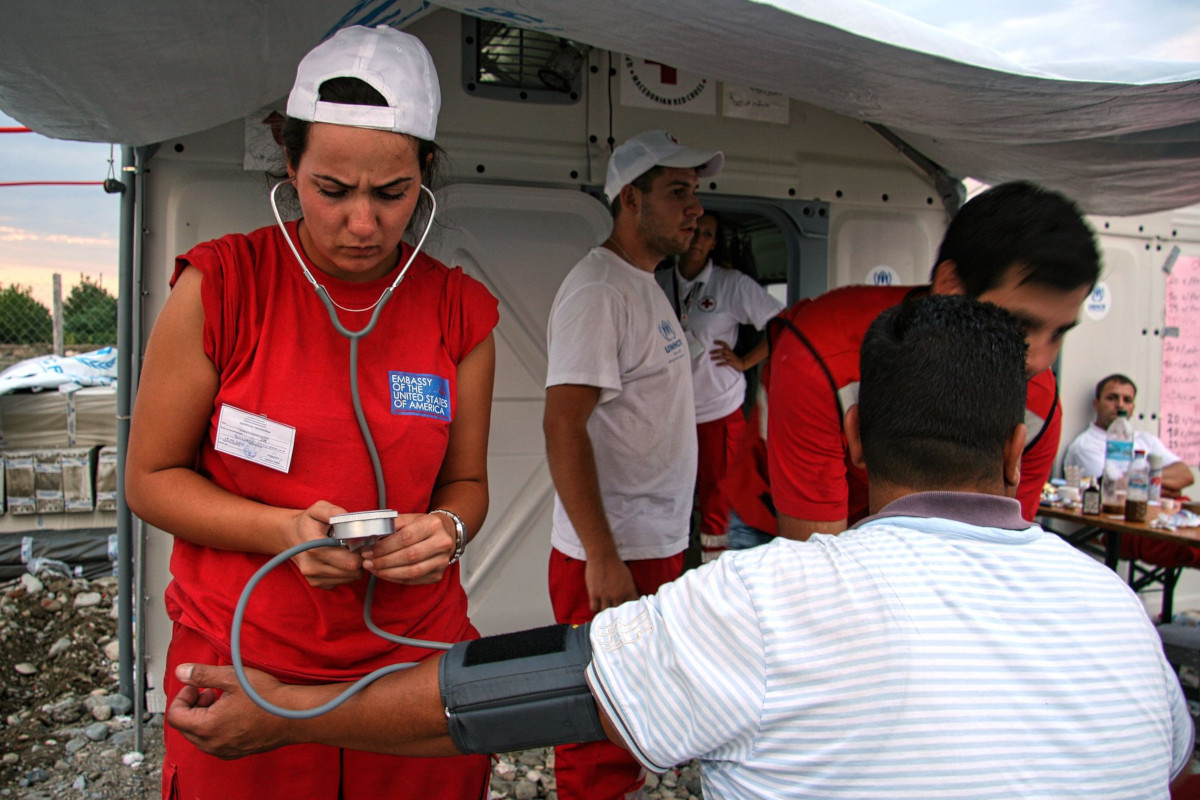
A Red Cross worker measures a man's blood pressure in 2015, when thousands of people were passing through Macedonia on their way to northern EU states. Image: IFRC, CC BY-NC-ND 2.0
This is, of course, not a new plan. In February and March 2016, as the EU-Turkey deal was heading for agreement and in the wake of the arrival of hundreds of thousands of people travelling by foot, road and rail to the ‘core’ of the EU, the ‘Balkan Route’ was declared closed by EU leaders. Initially done on the crude, discriminatory basis of nationality,[21] exclusion measures were extended to apply to all those crossing borders in the region. That process of closure continues today, and violence is a longstanding component of the strategy.[22] Indeed, it is a prerequisite for it to work effectively, and has been denounced repeatedly over the years by NGOs and international organisations. In March 2016, the Macedonian authorities sought supplies of pepper spray, tasers, rubber bullets, “special bomb (shock, with rubber balls)” and “acoustic device to break the mob.”[23] The concern now may be with smaller groups of people attempting to pass through the country, rather than with “the mob”, but the violence is no less brutal.
Help us bring you more reports like this
We can only produce articles like this with stable, independent support. Become a Friend of Statewatch and help us continue!
Taking externalisation seriously
In recent months there has been a renewed focus on rights violations at Europe’s borders, with perhaps more public and official interest in the issue than at any time in the last five years. Launching the Pact on Migration and Asylum in September 2020, Ylva Johanssen, the European Commissioner for Migration and Home Affairs, announced “a new independent monitoring mechanism for all Member States to implement in guidance with the European Agency for Fundamental Rights to make sure that there are no push backs at the borders.”[24]
Exactly one month later, allegations that Frontex deployments had knowledge of, or were involved in, pushbacks in the Aegean appeared in the media.[25] The revelations have sparked investigations by bodies such as the European Ombudsman and the European Anti-Fraud Office (OLAF) and the establishment of a permanent European Parliament working group to scrutinise the agency’s work, which is spending its first four months looking at alleged violations of fundamental rights.[26]
The proposed legal changes and the political inquiry have the potential to provide some measure of accountability for abuses, although both have serious shortcomings.
The Commission’s monitoring mechanism, without substantial changes, will do little to prevent the violence and pushbacks that have been documented at the Greek-Macedonian border and elsewhere in the region. In November 2020, eight human rights organisations called for the removal of geographical or procedural limitations to the mechanism; and new provisions to ensure independence, accountability, and consequences in cases where national authorities obstruct investigations.[27]
These changes would provide a much-needed check on the powers of the EU’s border authorities, even if they would effectively endorse the model of ‘border management’ that has led to increasing levels of violence against people on the move. It is also likely that the violence deployed on behalf of EU states as part of the attempt to close the Balkan Route would remain unaffected: border monitors could be deployed at the Greek-Macedonian border, but without effective means for ensuring the political and legal accountability of the Macedonian authorities – or the authorities of the non-EU states whose officials are deployed there – such a mechanism would do little for prevention or punishment.
Meanwhile, the outcome of the European Parliament scrutiny group’s investigation into the allegations of fundamental rights dogging Frontex remains to be seen. The group has no powers of enforcement or sanction against the agency, and while it is able to wield political pressure, its conclusions will undoubtedly be the subject of significant political wrangling between the different groups in the Parliament, all of whom have representatives participating in the group. Nevertheless, the recent decision by the Parliament’s budgetary control committee refusing to sign off Frontex’s finances for 2019, due to the unresolved allegations of human rights violations, indicates at least a basic level of consensus.[28]
What is certain is that the scope of the scrutiny group’s investigation into alleged rights violations has to go beyond the pushbacks document in the Aegean, and also look at the testimonies recorded by BVMN and other groups working in the Balkans. Allegations that the officials deployed at the agency’s behest have engaged in violence against people crossing borders may not be new, but this does nothing to diminish their seriousness. The suggestion that they may be operating on the territory of North Macedonia, a state in which they have no authority to act, is another question entirely. Frontex has denied its officers are present there, but by this point, seasoned observers have learnt not to take the agency’s claims at face value.
Chris Jones
Find out more
Explore our reporting and analysis on Frontex and the European border regime in the Statewatch Database
Endnotes
[1] “People beaten with metal batons and thrown into the river”, BVMN, 14 August 2019, https://www.borderviolence.eu/violence-reports/august-14-2020-0200-gevgelija-area-near-the-border-north-macedonia/
[2] As of 7 May 2021, BVMN has recorded 37 pushbacks from North Macedonia to Greece, dating from February 2019 onwards. The reports can be accessed here: https://www.borderviolence.eu/violence-reports/?ri-incident-location-geo-radius=50&ri-pushback_from=North%20Macedonia&ri-pushback_to=Greece&ri-underage-involved=all&ri-intention-asylum-expressed=all&ri-page=1
[3] “He said like, there is two flags every, every clothes so, there is the flag from the EU, like blue and with stars,” BVMN, 20 August 2020, https://www.borderviolence.eu/violence-reports/august-20-2020-1000-15-minutes-driving-the-north-macedonian-greek-border-near-gevgelija/
[4] The four categories are:
- Situations of high political and/or operational relevance especially with the potential to affect EU border management;
- Incidents occurring in Frontex activities/joint operations and not related to Frontex staff, or other participants in Frontex activities;
- Incidents involving Frontex staff and participants in Frontex activities;
- Situations of suspected violations of fundamental rights or international protection obligations.
Source: ‘Preliminary report of the Frontex Management Board Working Group’, 19 January 2021, p.29, https://www.statewatch.org/media/1814/frontex-wg-push-backs-preliminary-report.pdf
[5] ‘Preliminary report of the Frontex Management Board Working Group’
[6] Frontex Management Board Working Group, ‘Fundamental Rights and Legal Operational Aspects of Operations in the Aegean Sea’, 1 March 2021, https://www.statewatch.org/media/2024/agenda_point_wg_fralo_final_report.pdf
[7] ‘Evaluation Report: Joint Operation Flexible Operational Activities 2018 Land on Border Surveillance’, 6 May 2019, https://www.statewatch.org/observatories/frontex/frontex-publications/operations-reports/evaluation-report-joint-operation-flexible-operational-activities-2018-land-on-border-surveillance/
[8] Letter from Matthias Oel to Özlem Demirel, ‘Frontex operations in Greece’, 10 June 2020, https://www.bellingcat.com/app/uploads/2020/10/FOI-2-Transmission_letter-Frontex-to-MEP-DEMIREL.pdf
[9] Jane Kilpatrick, ‘Briefing: External action: Frontex operations outside the EU’, Statewatch, 11 March 2021, https://www.statewatch.org/analyses/2021/briefing-external-action-frontex-operations-outside-the-eu/
[10] Ismail Kamberi, ‘How are the Republic of North Macedonia and Frontex Handling the Refugee Crisis?’, respublica¸17 August 2020, https://respublica.edu.mk/en/blog/how-are-the-republic-of-north-macedonia-and-frontex-handling-the-refugee-crisis. The article cites statements from the North Macedonian interior ministry: ‘
Меморандум за разбирање меѓу Македонија, Австрија, Србија и Унгарија посветен на мигрантската криза’, 3 September 2015, https://mvr.gov.mk/vest/331; ‘Полициски службеници од Хрватска, Србија, а наскоро и од Унгарија, Словенија и Чешка заедно со македонските полицајци на јужната граница’, 29 December 2015, https://mvr.gov.mk/vest/1176
[11] ‘How are the Republic of North Macedonia and Frontex Handling the Refugee Crisis?’
[12] Figures published by the German government in response to parliamentary questions show that in the fourth quarter of 2020, Germany provided the following equipment to North Macedonia: 22 emergency vehicles for control and patrol duty (cost: €369,304); 350 pairs of boots / 60 flashlights with light attachment (€54,460); 10 mobile thermal imaging cameras (€98,400); 5 nail straps / 200 stop bars (€119,500); 5 Document review centre (“Dokumentenprüfcenter”, €119,500); 350 high-vis jackets (€6,650). Source: Antwort der Bundesregierung auf die Kleine Anfrage der Abgeordneten Ulla Jelpke, Dr. André Hahn, Gökay Akbulut, weiterer Abgeordneter und der Fraktion DIE LINKE, ‘Polizei- und Zolleinsätze im Ausland (Stand: viertes Quartal 2020)’, 24 March 2021, https://www.statewatch.org/media/2359/de-govt-figures-supplies-to-police-and-customs-abroad-fourth-quarter-2020.pdf
[13] ‘Croatian interior minister visiting North Macedonia’, Government of the Republic of Croatia, 25 February 2019, https://vlada.gov.hr/glavni-izbornik-14951/news/croatian-interior-minister-visiting-north-macedonia/25390
[14] ‘Prime Minister Andrei Babiš receives the Prime Minister of North Macedonia Zoran Zaev’, Government of the Czech Republic¸17 December 2019, https://www.vlada.cz/en/media-centrum/aktualne/prime-minister-andrei-babis-receives-the-prime-minister-of-north-macedonia-zoran-zaev-178744/
[15] ‘EU: Police chiefs: nine-point programme on keeping the 'Balkan Route' closed’, Statewatch, 12 July 2016, https://www.statewatch.org/news/2016/july/eu-police-chiefs-nine-point-programme-on-keeping-the-balkan-route-closed/
[16] ‘How are the Republic of North Macedonia and Frontex Handling the Refugee Crisis?’
[17] “They don’t care if he hit you in the eyes, in your head and just he hit you and push you in the Greek side,” BVMN, 16 August 2020, https://www.borderviolence.eu/violence-reports/august-16-2020-0100-kisava-north-macedonia/
[18] ‘Česká policie na makedonské hranici ‚proslula‘ násilím a vulgaritami, říká dobrovolník’, lidovky.cz, 19 March 2016, https://www.lidovky.cz/svet/ceska-policie-na-makedonske-hranici-proslula-nasilim-a-vulgaritami-rika-dobrovolnik.A160317_160113_ln_zahranici_sk
[19] ‘EU: Tracking the Pact: Reinforced cooperation against migrant smuggling with Balkan and African "partners"’, Statewatch, 15 October 2020, https://www.statewatch.org/news/2020/october/eu-tracking-the-pact-reinforced-cooperation-against-migrant-smuggling-with-balkan-and-african-partners/
[20] ‘EU support for "migration management" in the Western Balkans squarely focused on control measures’, Statewatch, 20 July 2020, https://www.statewatch.org/news/2020/july/eu-support-for-migration-management-in-the-western-balkans-squarely-focused-on-control-measures/
[21] Joint NGO statement, 3 March 2016, https://www.statewatch.org/media/documents/news/2016/mar/eu-border-closers-ngo-joint-statement.pdf
[22] ‘BALKANS: Sharp increase in violence against migrants since border closures in the Balkans - MSF consultations for violent trauma doubled since March’, Doctors Without Borders press release, 22 July 2016, https://www.statewatch.org/news/2016/july/balkans-sharp-increase-in-violence-against-migrants-since-border-closures-in-the-balkans-msf-consultations-for-violent-trauma-doubled-since-march/; ‘Western Balkans: Migrants and refugees are "routinely abused by law enforcement officials in the Western Balkans"’, Statewatch, 24 April 2017, https://www.statewatch.org/news/2017/april/western-balkans-migrants-and-refugees-are-routinely-abused-by-law-enforcement-officials-in-the-western-balkans/
[23] ‘Macedonian police teargas, pepper spray refugees at Greek border: Who supplied the "crowd control" equipment?’, Statewatch, 1 April 2016, https://www.statewatch.org/news/2016/april/refugee-crisis-macedonian-police-teargas-pepper-spray-refugees-at-greek-border-who-supplied-the-crowd-control-equipment-10-4-16/
[24] Speech by Ylva Johansson, ‘New Pact on Migration and Asylum’, 23 September 2020, https://ec.europa.eu/commission/commissioners/2019-2024/johansson/announcements/new-pact-migration-and-asylum_en
[25] Nick Waters, Emmanuel Freudenthal and Logan Williams, ‘Frontex at Fault: European Border Force Complicit in ‘Illegal’ Pushbacks’, Bellingcat¸ 23 October 2020, https://www.bellingcat.com/news/2020/10/23/frontex-at-fault-european-border-force-complicit-in-illegal-pushbacks/
[26] ‘Frontex under scrutiny: inquiries and investigations November 2020 onwards’, Statewatch¸ https://www.statewatch.org/observatories/frontex/frontex-under-scrutiny-inquiries-and-investigations-november-2020-onwards/
[27] Joint NGO statement, ‘Turning rhetoric into reality: New monitoring mechanism at European borders should ensure fundamental rights and accountability’, 10 November 2020, https://www.amnesty.org/download/Documents/EUR0133202020ENGLISH.PDF
[28] ‘2019 discharge: European Border and Coast Guard Agency’, https://www.europarl.europa.eu/doceo/document/TA-9-2021-0191_EN.pdf
Our work is only possible with your support.
Become a Friend of Statewatch from as little as £1/€1 per month.
Spotted an error? If you've spotted a problem with this page, just click once to let us know.
